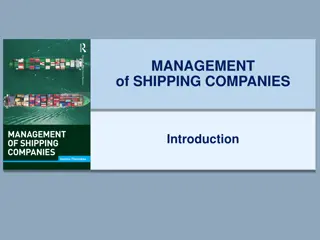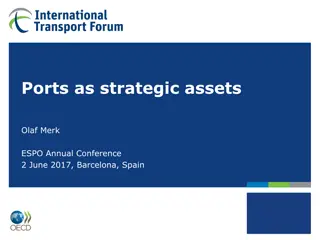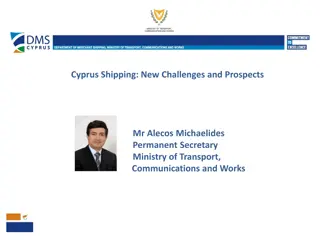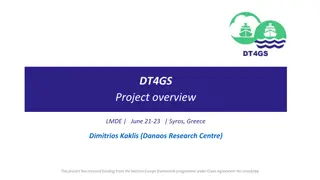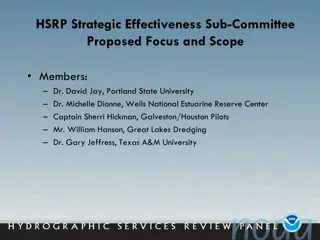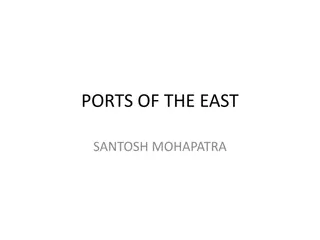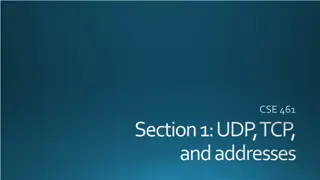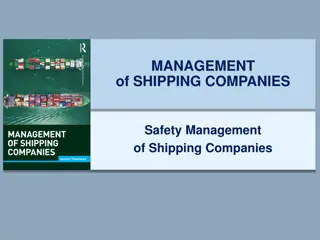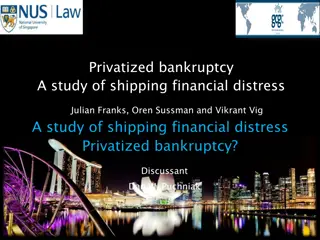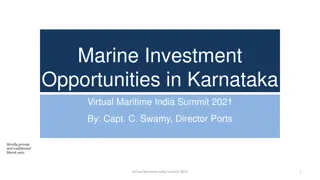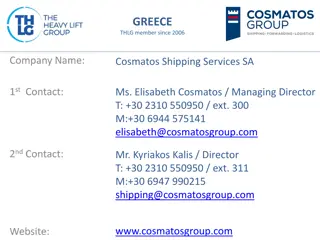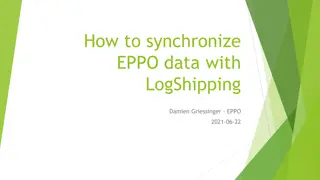The Potential of Cabotage for Domestic Shipping and Ports
Cabotage, the trade along a country's coast, plays a significant role in domestic shipping. This article explores the definition, advantages, requirements, challenges, and potential of cabotage as a policy instrument. It delves into the role of ports, customer satisfaction criteria, and offers recommendations for enhancing cabotage operations within the maritime industry.
Download Presentation

Please find below an Image/Link to download the presentation.
The content on the website is provided AS IS for your information and personal use only. It may not be sold, licensed, or shared on other websites without obtaining consent from the author. Download presentation by click this link. If you encounter any issues during the download, it is possible that the publisher has removed the file from their server.
E N D
Presentation Transcript
The Potential of Cabotage (Domestic Shipping) for Ports Simone Smith-Godfrey Smart Mobility 1
Contents Definition of Cabotage Introduction Cabotage Advantages Cabotage Requirements Primary Goals of Cabotage Challenges of Cabotage as Policy Instrument Inter-related Cabotage Challenges Cabotage Costs Structure Cabotage Customer Satisfaction Criteria Cabotage and Ports Positioning South African Ports Ports Alignment and Cabotage Ports Governance Structure Understanding the Port Elements Ports Cost Structure Recommendations 2
Cabotage Definition Cabotage is defined as the carrying on of trade along a country s coast, the transport of goods or passengers from one port to the next in the same country. In Black s Law Dictionary (8th Ed), pg 215, Cabotage as the privilege to carry on this trade usually limited to vessels flying the flag of that country . The Webster Dictionary defines it as the navigation and movement of ships in coastal waters, restriction of the use of coastal waters and airspace by a country to its own domestic traffic The word Cabotage is a nautical term from Spanish, denoting strictly navigation from cape to cape along the coast without going into the open sea. It also has root in French as a language and is derived from the word Caboter which means sailing from coast to coast. 3
Introduction Comprehensive Maritime Policy 2017 and Merchant Shipping Act 2018 Revised African Maritime Transport Charter make provision for Cabotage and calls for it to encourage the development of national fleets and continental shipping lines Paper is considering Cabotage as a viable solution Also considers the interrelated challenges for cabotage potential for freight and passenger Reviews possibility of integrating cabotage in intermodal value chains By assessing the requirements of cabotage customer satisfaction criteria Role of ports are reviewed to bridge shore-based infrastructure And make recommendations based on it 4
Cabotage Advantages According to Paragraph 149, on Page 62 of the Comprehensive Maritime Transport Policy the following are indicated as the advantages of Cabotage: 1. Cabotage as an alternative is more fuel efficient than roads, 2. It assists in decongestion of the road network, 3. Economic and convenient to transport heavy cargo between major centres and so reduce the carbon footprint, and 4. Cabotage is cheaper over appropriate distances than any other form of transport, especially road. 5
Cabotage Requirements Cabotage has 4 requirements; Built in the Country, Owned by a National, Flagged by the Country and Crewed by Nationals To Build a general cargo ship (less than 1000 TEUs) have not yet been done by South African shipyards. To have it Owned requires currently unavailable credit facilities from the local banks. Getting the money offshore is difficult based on the country s credit profile. To Fly the local flag is problematic due to the tax regulations which have changed to charging tonnage of vessel tax and not tonnage carried. It is a risk that makes the ship s register competitive by compromising the reputation of the ship s register and cutting the potential tax it may have earned the country To Crew the ship by nationals is difficult as the National Cadet Programme has not yet turned out high ranking and experienced officers and masters for merchant shipping purposes. 6
Primary Goals of Cabotage 1. increase efficiency of transport chain modes. Cabotage can handle 1000 TEUs at a time where road transport can do at most two containers at a time and rail around 80 wagons on average. 2. reduce costs in the different modes infrastructure Cabotage needs to pay for using infrastructure in the ports. 3. be integrated with the carriers Use Through Bill of Lading for integration of transport modes 4. Consideration for transport s ecological needs. Cabotage s carbon footprint is smaller and more ecological friendly. 7
Cabotage Policy Instrument Challenges The persuasion, adequacy and appropriateness determines the success of policies. Cabotage as concept requires institutional set up, facilitation standards and port-specific measures. It involves an intermodal approach where each transport mode is represented. To integrate cabotage in the transport value chain. By ensuring that cabotage is not viewed as competition but complementary. Ports are essential links to this as the distances for cabotage movement are short, so rapidity and agility is required. 8
Inter-related Cabotage Challenges Cabotage must keep up with consumer growth to satisfy customer needs. Cabotage needs to be viewed as part of a holistic approach to production, by being included in the transport network. Standardization of cost structures across the transport network, which is market related. Mode-functional innovation needs to take place in ship design, its construction, the ship-terminal system and the loading and off-loading technology, which is technical related. Rules on sea is stricter than rules on land. 9
Cabotage Cost Most obvious determinant of Cabotage cost is Distance. 3 triggers to Cabotage Economics: 1. Maximization of Revenues through flexibility of multipurpose ships. 2. Economy of Scale as the more cargo is carried on board, the lower the running cost and voyage cost, resulting in lower freight rate. 3. Cost Reduction in Capital Investment, Port Cost, Cargo Handling Cost. 10
Cabotage Customer Satisfaction Criteria 1. Frequency of sailing, as distances are shorter, leading to higher flexibility, providing for reliability. Satisfy the time needed for the voyage and the cost of it, by using faster vessels, suitable for all weather conditions. Environmental impact of cabotage must be of an acceptable nature. Political acceptability of the mode of transport, especially in a country such as South Africa. The role of ports are critical as it is the connecting node on the cabotage routes. The readiness of ports to deploy fairly small adjustments will determine the efficiency of cabotage vessels. Cabotage vessels comes with its own gear, that decreases Ship Turn Around Time. Cabotage can find a home in the Hub and Spoke Network of shipping lines. 2. 3. 4. 5. 6. 7. 8. 11
Cabotage and Ports Positioning SA ports are not homogenous in nature and act rather as ports where complementary services are provided. This means that cabotage vessels must be linked to the correct ports to determine the routes to follow. These routes are depended on the specific cargo mix that is being handled. Saldanha, Richards Bay and Mossel Bay are predominantly bulk export ports. Durban, Cape Town and East London are multipurpose ports. With Ngquru handling for transhipments. 12
The South African Ports Ports has systematic complementarities Ascribed to singular nature of port ownership Where all marine services are provided for under TNPA. The port terminals are not all operated by Transnet Port Terminals, but a few private operators within the same port, does exist. 13
Ports Alignment to Cabotage TNPA need to be guided by the CMTP, the Merchant Shipping Act and the National Ports Act for the desirability of cabotage. 1. By evaluating the ports governance structure. 2. Then review ports and terminals with the port elements. 3. Which is closely related to the evaluation of ports costs for cabotage 14
1. Ports Governance Structure South African ports have a long history in terms of its ownership changes and observations regarding the evolution of such changes in ownership is seen in its operating models. From 1833 to 1908, the ports were an autonomous body with each port administering its own tariffs and so competing with each other. In 1909 the South African Railways and Harbours were formed and existed up until 1981 and saw a unification of both the harbour and railway authorities. In 1989 Transnet was formed to commercialized the activities of the South African Transport Services, with the government as the sole shareholder of five divisions, namely; Spoornet for rail, Portnet for ports, Petronet for pipelines, Autonet for roads and South African Airways for air transport. In 2002, Portnet became divided into a landlord port authority called Transnet National Ports Authority and a port operator called Transnet Ports Terminals as a result of the passing of the National Commercial Port Policy of 2002. In 2007, the Ports Regulator was formed as been provided for in the National Ports Act of 2005. 15
2. Port Elements The port level activities are critical to the success of any transport network. Delays in Admin, Ops and Comms result in time constraints and penalties as well as monetary losses. Four main elements: Port access cabotage vessels do not need additional access improvements to be made as the vessels are small enough and the navigational aids are sufficient. (Operations Element) Port area allowing efficiency to correlate with port charges, safety and port environment, relative to the port charges for cabotage vessels. (Administrative Element) Port Layout linkages in existing or new links which on the surface does not need investment as it already exist. (Infrastructure Element) Port Hinterland cabotage can give road and rail a competitive edge which is highly relevant i.t.o costings to the shipper and the consignee. (Connectivity Element) 1. 2. 3. 4. 16
3. South African Ports Cost Structure SA runs a complementary ports system where the cost of using the ports are not reflected in the prices charged. Revenues so earned and costs allocated to specific commodities remain unjustified. The complementary port systems allows for intra-port, inter-port and multimodal cross-subsidization as TNPA is a part of the Transnet SOC. Current Tariff structure is that of Required Revenue and since the inception of the Ports Regulator the most contentious issue from port users. Model is seen as an impediment to export competitiveness of the country as the tariffs are not determined by demand but by what is required to generate revenue. Furthermore, argued that User-Pay principle used in determination of tariffs is not compatible with the policies of the country nor with the complementary port system. 17
Recommendations Establish if the new legislation and policies work towards the implementation of corporatizing the TNPA as split is key to achieve its mandate Focus on the existing infrastructure and available superstructure from an efficiency perspective that allows usage by cabotage operators. Enhance port connectivity with road and rail linkages with a cabotage linkage. Determine the weak areas in the port call organization, loading and offloading of cargoes and find mitigative strategies around it. Implement Real Time Information Systems between the ports and cabotage operators to allow consistent updated information on current status of the ports value chain. Establish an appropriate tariff structure that fosters its development and uptake in SA, in such a manner that it may compete i.t.o cost structure with Road and Rail. 18
Thank you. 19


